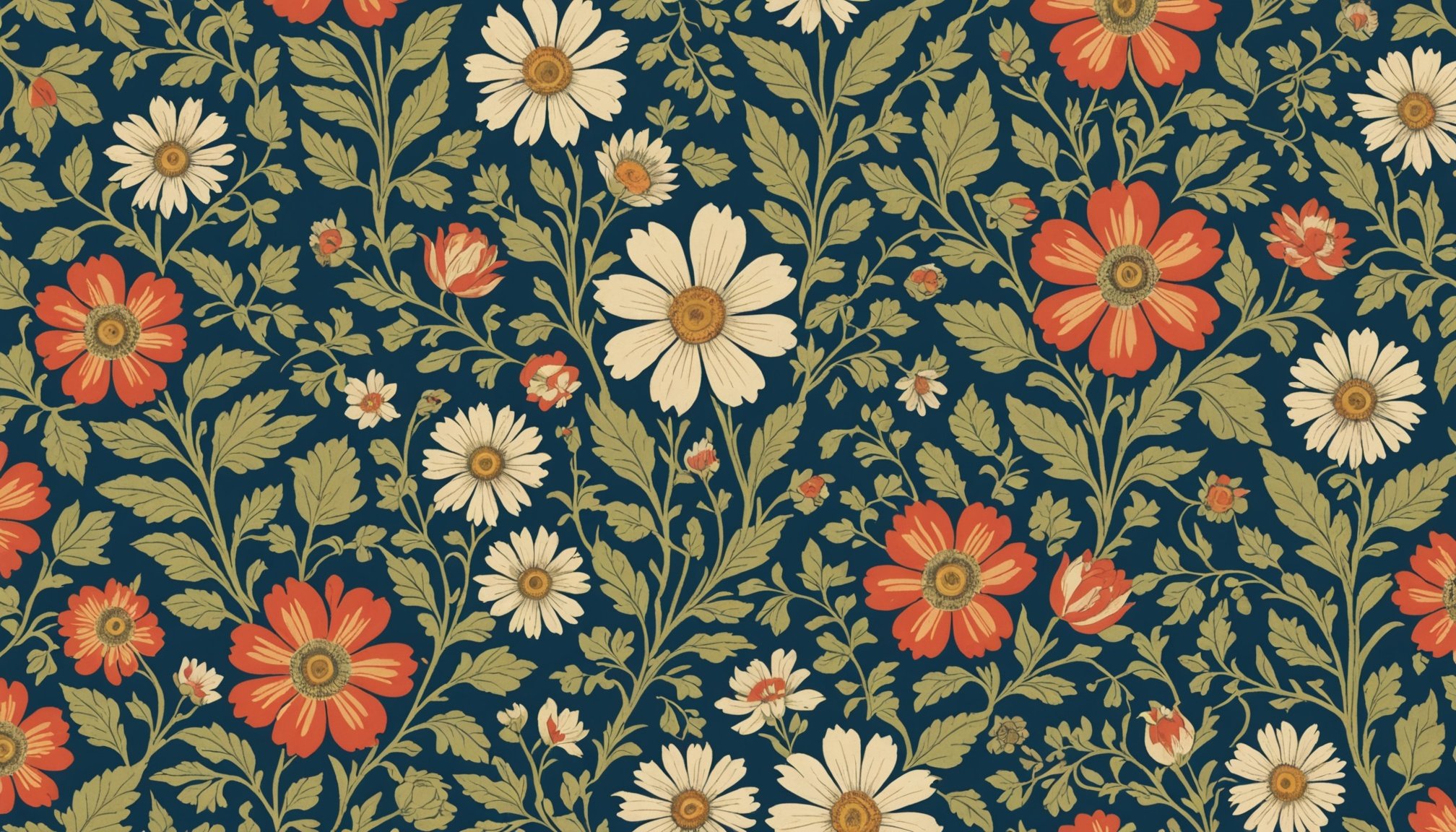Overview of British Wallpaper Design
The historical significance of wallpaper in British culture is profound, tracing back centuries as an indicator of both status and aesthetic evolution. Initially serving as a luxury for the aristocracy during the Renaissance, wallpaper became a medium to reflect evolving tastes and technologies.
Throughout the centuries, the evolution of wallpaper design styles has been marked by significant cultural and artistic shifts. During the Victorian era, intricate floral patterns and rich textures mirrored the opulence of the time. The Arts and Crafts movement, led by figures such as William Morris, introduced nature-inspired motifs and handcrafted techniques as a counteraction to industrialization.
Also to see : Explore the UK’s Essential Stops to Discover Captivating Stories of the British Civil War
Several major influences have shaped British wallpaper aesthetics. The 18th-century Chinese influence, with its delicate depictions of flora and fauna, added exotic elegance. The 20th century saw modernist styles gaining ground, characterized by geometric forms and experimental use of colour.
In more recent years, there has been a resurgence in appreciation for vintage and artisanal designs, as well as sustainable production methods. This renaissance echoes a broader cultural interest in craftsmanship and authenticity, reaffirming wallpaper’s enduring place in British interior design. This continued evolution showcases wallpaper not merely as decoration but as a canvas telling stories of cultural and historical narratives.
In the same genre : Explore the Top UK Cities for Engaging Guided Tours of British Brewing Heritage
Types of British Wallpaper
British wallpaper design boasts a rich array of types and styles, each reflecting a unique blend of history and innovation. Among the most popular types are flock, damask, and toile, each bringing its distinct texture and historical flair to interior spaces. Flock wallpapers, with their raised, velvety patterns, hark back to the luxury of the 17th century, offering a tactile and opulent feel.
When it comes to patterns and motifs, British wallpapers often feature classic designs such as paisleys, stripes, and the ever-popular floral arrangements, reminiscent of nature and traditional English gardens. These patterns not only embellish walls but also tell stories of heritage and artistic evolution.
Materials used in British wallpaper production range from traditional paper to modern alternatives like vinyl and non-woven fabrics. Non-woven wallpapers, in particular, offer durability and ease of installation, becoming a favourite in contemporary homes.
Incorporating these various wallpaper types and materials allows for a mixture of historic grandeur and modern practicality, keeping British wallpaper firmly rooted in both tradition and trend. Whether seeking to preserve the charm of a bygone era or looking to make a contemporary statement, the diversity in British wallpaper provides endless possibilities.
Notable British Wallpaper Designers and Companies
British wallpaper design has seen remarkable contributions from legendary figures and innovative brands, each elevating the field with unique craftsmanship. Key designers like William Morris are renowned for integrating nature-inspired motifs through intricate detailing, setting a high benchmark in aesthetics. John Henry Dearle also stands out for his work alongside Morris, continuing to influence wallpaper with artistic flair that resonates with nature and folklore.
Prominent design companies, such as Cole & Son and Sanderson, are celebrated for their dedication to authenticity and quality. Cole & Son’s historic archives, paired with Sanderson’s innovative techniques, offer a rich tapestry of motifs and styles, from traditional damasks to modern, geometric designs.
Craftsmanship remains central to these designers and companies, emphasising meticulous attention to detail and artisanal methods. This commitment ensures a balance between tradition and modernity, bringing forth wallpaper collections that are not only decorative but also testament to British artistic excellence.
For enthusiasts, the work of these designers and companies offers inspiration, with each piece telling a story of heritage and evolution. Understanding their contributions enriches appreciation of the artistry behind British wallpaper.
Hands-On Workshops Overview
Engaging in wallpaper workshops offers a dynamic approach to understanding British wallpaper design, providing a rich blend of experiential learning and art exploration. These workshops are vital for enthusiasts who wish to delve into the intricate world of wallpaper, offering hands-on experience that goes beyond theoretical knowledge.
Participants typically embark on a journey of discovery, where they are introduced to traditional techniques and contemporary styles within British wallpaper design. By engaging directly with materials and tools, attendees gain practical insights into the art and craft involved. This immersive environment allows learners to appreciate the design styles and historical significance of wallpaper in a tangible way.
Travellers have a unique opportunity to incorporate these workshops into their itinerary, with sessions often designed to complement both short and extended visits. The benefits of participating are manifold; from developing new skills to fostering an appreciation for the aesthetic nuances and cultural heritage embodied in British wallpaper.
These workshops not only enrich personal creativity but also provide a platform for connecting with like-minded individuals and experts. By immersing themselves in such experiences, participants walk away with a deeper understanding and an enhanced appreciation for the artistry and craftsmanship behind British wallpaper design.
Locations and Schedules of Workshops
Engaging in wallpaper workshops across the UK offers a diverse range of experiences for enthusiasts eager to dive into British wallpaper design. Various cities, from London to Edinburgh, are hosts to these creative hubs, providing access to rich experiences for everyone looking to learn.
Workshops typically take place in well-known design centres and historical venues, immersing participants in the authentic history of wallpaper design. Cities renowned for their artistic heritage, such as Bath and York, offer unique settings perfect for exploring types of wallpaper, patterns, and materials in engaging hands-on classes.
Schedules can vary, with sessions generally spanning from half-day to full-week programs, allowing flexibility for both short visits and extended stays. Classes often run during weekends to accommodate travellers, with a focus on experiential learning and interactive activities led by industry experts.
Booking details for these workshops can usually be found directly on the hosting venues’ websites. Early registration is recommended to secure a spot, as these sessions are highly popular. Participants are encouraged to review the detailed descriptions and reviews to tailor their experience according to personal interests and schedules.
Additional Resources and Reading
For those fascinated by the intricacies of British wallpaper design, diving into further reading and resources enriches understanding and appreciation. Exploring educational materials and books about wallpaper provides deeper insights into its history and contemporary trends.
A highly recommended resource is “The Wallpaper Book” by Genevieve Brunet, offering a comprehensive overview of wallpaper’s evolution. It covers various types of wallpaper, patterns, and installation techniques. Another invaluable read is “Wallpaper in Interior Decoration” by Gill Saunders, which focuses on design styles and how they have adapted over the years.
Online platforms, such as the Victoria and Albert Museum’s website, provide access to digitized archives and articles exploring the history of wallpaper. The design process and techniques are often highlighted through blog posts and interviews with designers, providing a modern perspective.
For hands-on enthusiasts, The Wallpaper History Society’s website hosts a wealth of information and hosts discussions on current trends and wallpapers’ role in British culture. Their forums are ideal for connecting with like-minded individuals eager to share experiences and workshop tips.
Engaging with these resources offers a comprehensive guide to the storied art of wallpaper, from its historical origins to its contemporary applications in modern design.
Tips for Participants
Embarking on a wallpaper workshop can be a rewarding experience, especially when you’re well-prepared. Here are some valuable workshop tips to enhance your journey. First, research and gather information about the workshop location and instructors. Knowing your travel preparation helps in planning routes and schedules.
When packing, consider bringing a notebook and camera. They’ll help you capture key insights and memorable moments. Dress comfortably, as workshops often involve hands-on activities that might be messy.
Active participation is crucial. Engage with instructors and peers to maximise learning. Ask questions, share ideas, and don’t hesitate to seek feedback on your creations.
Fostering connections with fellow enthusiasts during these workshops can open up opportunities for collaboration and learning long after the event ends.
Expect a mix of theory and practice. Workshops can cover historical context alongside modern techniques. It’s about combining tradition with innovation.
Finally, reflect on your experiences. Document your thoughts and takeaways. Enhance your learning by revisiting books, articles, or discussions post-workshop. Effective preparation and engagement not only elevate your participant experience but also deepen your appreciation and understanding of wallpaper art.
Participant Experiences and Testimonials
Engaging in wallpaper workshops offers transformative experiences, enriching participants’ understanding of British wallpaper design. Participant testimonials highlight personal growth and artistic revelation. One workshop attendee shared, “The hands-on approach allowed me to truly grasp the complexity and beauty of design styles I had previously only read about.” Such experiences emphasize the importance of tactile learning in comprehending intricate patterns and techniques.
Workshop attendees frequently express a newfound appreciation for the history and craftsmanship involved in wallpaper design. Many report that the workshops enhance their ability to discern and appreciate diverse types of wallpaper, from flock to toile. Additionally, practical skills gained during these sessions often empower participants to apply learned techniques in their own projects, creating bespoke and personal designs.
Interviews with past participants reveal that workshops significantly impact their understanding and appreciation of the craft. Discovering the narrative behind designs and motifs, many find their creativity rejuvenated and their perspectives broadened. These stories collectively illustrate the workshops’ power to foster a deep connection to wallpaper art, validating its role as both a historical artifact and a contemporary medium of expression.
Insights from Workshop Leaders
Engaging directly with workshop leaders offers a unique window into the intricacies of wallpaper design. These experts bring a wealth of knowledge, sharing their expert insights through tailored teaching methodologies. Their deep understanding of British wallpaper design translates into engaging sessions that blend history with creativity.
Workshop leaders often employ teaching methodologies that emphasize hands-on experiences. This approach allows participants to grasp the tactile nature of wallpaper production, combining theory with practice. Leaders guide attendees through various design styles, revealing secrets behind intricate patterns and craftsmanship.
Interviews with these leaders highlight the value of mentorship in nurturing creativity. They encourage participants to explore and innovate, creating a supportive environment where questions and experimentation are welcomed. This fosters an atmosphere of collaborative learning, where both novices and experienced individuals benefit from shared knowledge.
The leaders’ insights into the design process often include discussions on material selection and implementation of diverse artistic techniques. These sessions provide rich learning opportunities, enabling participants to appreciate the multifaceted nature of wallpaper design. Engaging with such knowledgeable figures empowers individuals to go beyond basics and truly embrace the art and craft of British wallpaper design.











